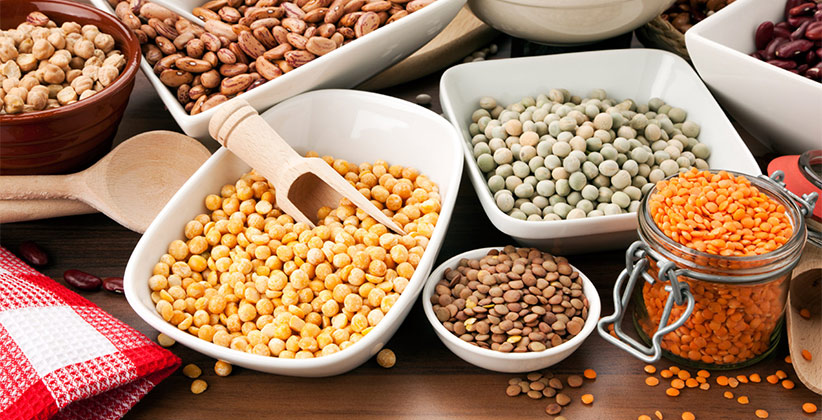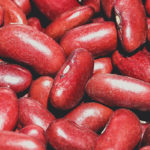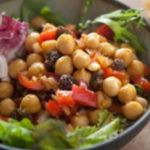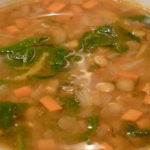Analytical tests:
- Identify the quality characteristics of pulses
- Determine end use of the pulses
- Help pulse researchers and plant breeders understand the effect of environment on pulse crop quality
Pulse methods and tests
Colour
Colour of dehulled lentils is measured using a Hunterlab LabScan XE spectrocolorimeter using the CIE (1976) L*, a* and b* colour scale with a D65 Illuminant. L*=darkness (0) to brightness (+); a*=greenness (-) to redness (+); b*=blueness (-) to yellowness (+).
Cooking time
Cooking time is determined using an automated Mattson cooker as described by Wang and Daun (2005), Journal of the Science of Food and Agriculture 85:1631-1635. The automated Mattson cooker consists of a cooking rack and 25 hollow plungers. The weight of each plunger is adjusted to 90 g. A sample (30 g) is soaked in distilled water at room temperature (22±2°C) for 24 h. Soaked seeds are then positioned into each of the 25 saddles of the rack so that the tip of each plunger rests on the surface of the seed. The rack is then placed into a 2 L metal beaker containing 1.2 L of boiling water. When a seed becomes sufficiently tender, the plunger penetrates the seed and drops a short distance through the hole in the saddle. The time taken for each plunger to drop is automatically recorded. Cooking time for a sample is defined as the time required for 80% of the seeds to be penetrated.
Dehulling characteristics of red lentils
Dehulling characteristics of red lentils are determined using a Satake TM05C Grain Testing Mill (Satake Engineering Co Ltd, Hiroshima, Japan) in accordance to the procedure described by Wang (2005), Cereal Chemistry 82(6):671-676. Lentil seeds are passed through a series of sieves with 4.5, 5.0 and 5.5 mm holes and separated into fractions. The fraction ranging from 4.5 to 5.0 mm is used. Samples (30 g) are tempered to 12.5% moisture before they are dehulled. The tempered lentils are then processed in the mill for 38 sec. The speed of rotation of the abrasive wheel is operated at 1100 rpm. After dehulling, the powder is collected using a No. 20 mesh sieve and the rest of the product is separated into whole seeds, split seeds, broken seeds and hulls using a dockage tester (Simon-Day Ltd., Winnipeg, Canada). Both split and whole seeds are further separated by hand into their respective hulled and dehulled classes. All fractions are weighed and expressed as a proportion of the total original weight. Dehulling efficiency (%) is calculated as the sum of dehulled whole seed (%) and dehulled split seed (%).
Firmness of cooked pulse seeds
Firmness of cooked seeds is measured with a TA-HDi texture analyzer (Texture Technologies Corp., Scarsdale, NY) according to the method described by Wang et al (2010), Food Chemistry 118:109–115. A TA-91M Kramer Shear Cell (Texture Technologies Corp., Scarsdale, NY) is used. Firmness of cooked seeds is defined as the maximum force required to shear the cooked seeds and expressed as the maximum shear force per gram of cooked sample (N/g cooked sample). Values reported are averages of six determinations.
100-seed weight
100-seed weight is determined according to the AACC method 56-35.01. Broken and damaged seeds along with foreign material were handpicked from a sample. One hundred seeds are counted using a custom-made seed sampling paddle and weighed.
Protein content
Protein content (N x 6.25) is predicted by near-infrared (NIR) spectroscopy using a NIRSystems 6500 scanning near-infrared spectrometer. The instrument is calibrated and results are verified by the AOAC Official Method 992.23 – Crude Protein in Cereal Grains and Oilseeds Generic Combustion Method using a LECO Model FP-428 CNA analyzer. Protein content is reported as percentage calculated on a dry matter basis.
Seed size distribution
Seed size distribution is determined using the Image Analysis technique developed at the Canadian Grain Commission.
Starch content
Starch content is determined by the AACC method 76-13.
Water absorption
Water absorption or hydration capacity defined as the maximum amount of water that 100 seeds absorb at room temperature (22±2°C) is determined by the AACC method 56-35.01.
If you are Looking for a pulse exporter in Canada, call AdasCan Grain at +1 (416) 548-5901
Extracted from: https://www.grainscanada.gc.ca/pulses-legumineuses/method-methode/pmtm-mmal-eng.htm





Comments are closed.